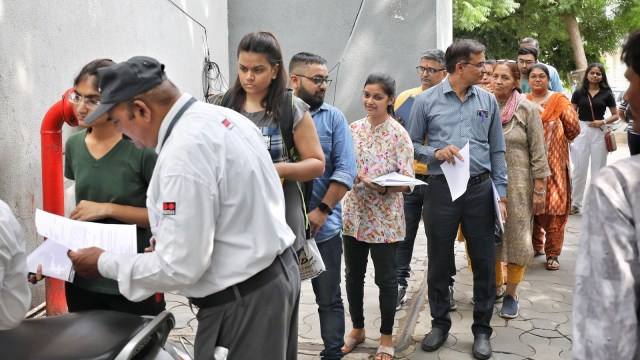Punjab immigration study shows fall in remittances, says unemployment chief reason for moving abroad
The study, which shows a massive gap between the expenditure incurred and the amount sent back by migrants, highlights that the migration channel was legal in 98.53 per cent of the cases.
 The research was released in the form of a book titled Demographic and Socio-Economic Analysis of International Migration from Rural Punjab, published recently in Patiala. (Express Photo)
The research was released in the form of a book titled Demographic and Socio-Economic Analysis of International Migration from Rural Punjab, published recently in Patiala. (Express Photo)Unemployment in Punjab is a major reason, according to a study, for people from rural Punjab to migrate to foreign shores. Although they have left home for better economic and social life, the remittances they sent back leave a lot to be desired.
As per the study, conducted in 98 Punjab villages by six researchers, 81.38 per cent of the migration happened in 2012-2021, 14.05 per cent in 2001-2011 and only 4.55 per cent happened in 2000 or before.
The researchers studied the pattern of migration from 1951 to 2021. They were provided yearly migration data from 2001 onwards as only 127 people in the sample size migrated in 1951-2000. However, the redeeming feature is that the migration channel was legal in 98.53 per cent of the cases.
The research was released in the form of a book titled Demographic and Socio-Economic Analysis of International Migration from Rural Punjab, published recently in Patiala.
The researchers were Dr Gian Singh, a retired professor of economics, Punjabi University, Patiala; Dr Gurinder Kaur, a retired professor of geography, Punjabi University; Dr Dharampal, an assistant professor at Himachal Pradesh University; Dr Sukhvir Kaur, an assistant professor, SGPC College, Zirakpur; Dr Jyoti, an assistant professor, SD College in Kheri Gurna, affiliated to Punjabi University and Dr Rupinder Kaur, an assistant professor, Punjabi University.
| Year | Number of migrants | % |
| 2021 | 375 | 13.45 |
| 2020 | 149 | 5.39 |
| 2019 | 463 | 16.61 |
| 2018 | 389 | 13.95 |
| 2017 | 275 | 9.86 |
| 2016 | 194 | 6.96 |
| 2015 | 170 | 6.10 |
| 2014 | 111 | 3.98 |
| 2013 | 38 | 1.36 |
| 2012 | 105 | 3.77 |
| 2011 | 43 | 1.54 |
| 2010 | 107 | 3.84 |
| 2009 | 40 | 1.43 |
| 2008 | 58 | 2.08 |
| 2007 | 40 | 1.43 |
| 2006 | 16 | 0.57 |
| 2005 | 34 | 1.22 |
| 2004 | 11 | 0.39 |
| 2003 | 11 | 0.39 |
| 2002 | 27 | 0.98 |
| 2001 | 5 | 0.19 |
| 2000 and before | 127 | 4.56 |
The study said slightly fewer than two-thirds of the migrants (63.52 per cent) sent remittances back home, whereas more than one-third (36.48 per cent) did not send any amount in remittance. Out of total migrants who sent remittances, 63.02 per cent had sent up to Rs 5,00,000 only. Only 14.68 per cent of the migrants had sent remittances of Rs 10,00,000 and above to their families in Punjab.
Dr Gian Singh said, “The study highlights a disturbing fact that there was a massive gap between the expenditure incurred and the amount sent back by the migrants, which clearly indicates a ‘capital drain’ from India and Punjab.
“Around a decade ago, the trend was that people or students migrated to foreign countries, got work within a few days, and started sending remittances back home to their families. Now the trend has changed. Students in lakhs migrate to foreign shores by spending massive amounts every year. They are facing difficulties in finding jobs. Moreover, the cost of living has increased tremendously in foreign countries.
“So, nowadays, it has become challenging to survive in foreign countries, especially in Canada and Australia. Some gurdwaras are arranging langar (free meals) and providing shelter for Indian students in these countries. In such a situation, they cannot send money to their families. Instead, they force their parents/families to send more money to them.
“Because of this, around two-thirds of the households (65.85 per cent) were in debt, and out of these, 44.01 per cent households were in debt of up to Rs 10 lakh. The households in debt of Rs 10 lakh to Rs 15 lakh and Rs 15 lakh to Rs 20 lakh were 14.71 per cent and 5.70 per cent, respectively. Even 1.43 per cent of the households were in debt of Rs 20 lakh and above.”
Of the 98 villages selected for the survey, 20 were from Majha, 21 from Doaba, and 57 from Malwa. All the households in these villages from which any individual had left Punjab for greener pastures from 1951 to 2021 were surveyed. Such households were 358 in Majha, 947 in Doaba, and 1,292 in Malwa, which formed a total sample of 2,597 households in rural Punjab, according to the study.
81.38% of the total migration happened between 2012- 2021
| Decade | Number of migrants | % |
| 2012-2021 | 2269 | 81.38 |
| 2001-2011 | 392 | 14.06 |
| 2000 and before | 127 | 4.55 |
Out of the total households of migrants from rural Punjab, 28.80 per cent had landholdings in the range of 2.51 to 5 acres. Slightly more than 18 per cent of the households had landholdings up to 2.50 acres. As many as 11.55 per cent, 10.98 per cent, and 8.97 per cent of the households had landholdings in the ranges of more than 10 acres, 7.51 to 10 acres, and 5.01 to 7.50 acres, respectively. Out of the total migrant households, 21.63 per cent had no farmland, the study said.
The migration channel was illegal only in 1.47 per cent cases. Of the total people who migrated legally, more than half (53.88 per cent) migrated on study visas, while slightly more than one-third, that is, 34.80 per cent migrated on work visas. Interestingly, 3.59 per cent of the migrants were unemployed prior to their migration, as per the study.
In 79.95 per cent cases, the family members stated that unemployment was the main reason for the migration. Better living conditions and good administration attracted 70.09 per cent of the migrants, the study said, adding that 23.71 per cent of the people migrated for higher education.
The most preferred destinations are Canada, UAE, Australia, the UK, the US, Italy, and New Zealand.
Of the total 2,788 migrants surveyed, 16.61 per cent migrated in 2019, 13.95 per cent in 2018, 13.45 per cent in 2021, 9.86 per cent in 2017, 6.96 per cent in 2016, 6.10 per cent in 2015, 5.34 per cent in 2020, and less than 5 per cent in each of the other years, the study said, adding that more than half of the migrants (51.61 per cent) were motivated by their relatives to move abroad.












